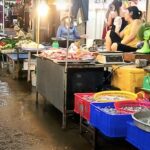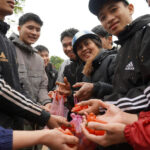A Historic Landmark on the Tien River
Cai Be floating market dates back to the late 17th century, coinciding with the Vietnamese’s southern land exploration. Back then, with limited roads, traveling by boat was the primary means of transportation, making the floating market a vital trading hub.
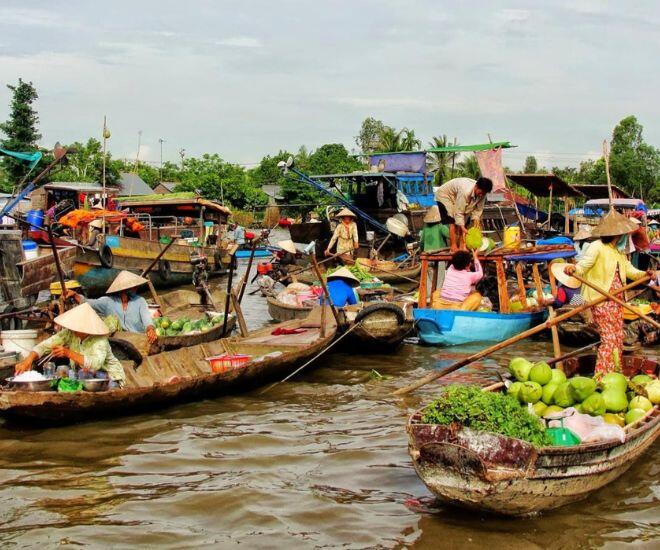
According to the historical records in Dai Nam Nhat Thong Chi, during the Nguyen Dynasty, Cai Be was recognized as a crucial transshipment center for goods between the Western and Eastern regions of Southern Vietnam. Its strategic location at the confluence of the Tien River contributed to its development as a bustling trading post.
Stretching along the Tien River, the Cai Be floating market spans about 1,000 meters from Cai Be Bridge to Long Hai estuary. The market is divided into specialized sections: a fruit-selling area near the church intersection, a vegetable and fruit section along the river, and a separate section for rice and husked rice trading.
The Golden Age of the Floating Market
The floating market thrived during the 1980s and 1990s, with hundreds of boats gathering day and night. The market buzzed with activity during high tide, especially from 4 a.m. to 9 a.m.
A Treasury of Local Produce
Beyond a mere trading post, Cai Be floating market showcases the unique culture of the Western region of Southern Vietnam. A distinctive advertising system involves hanging products high on poles, creating a distinctive identity for the market. From a distance, visitors can identify what each boat sells by spotting mangoes, banana stems, or coconuts suspended in the air.
Fruit remains the market’s signature commodity. Green-skinned grapefruit, vu sua Lo Ren (a variety of milk-fleshed custard apple), and Cai Be tangerines are among the famous specialties traded here. In the past, daily fruit sales reached tons, attracting traders from Saigon and the Eastern region.
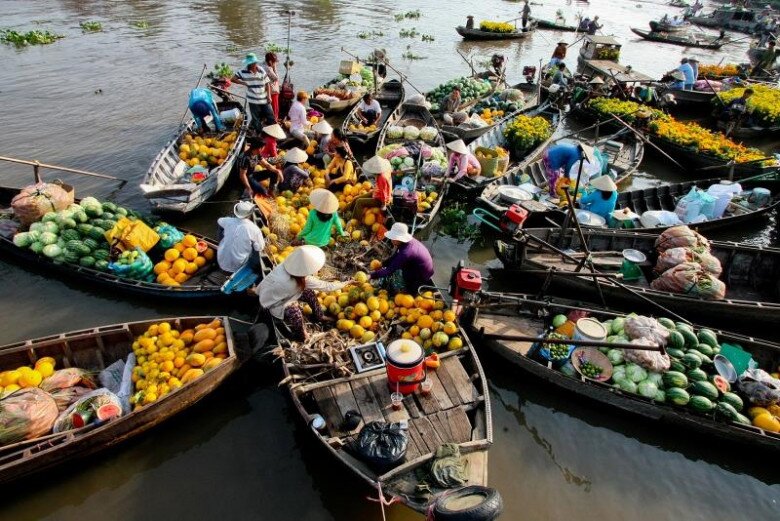
In addition to fruit, the market offers a variety of fresh seafood, including snakehead fish, basa fish, and green mustached shrimp. Agricultural products such as rice, husked rice, and vegetables are also traded, catering to the needs of locals and traders alike.
Another unique feature of the floating market is the presence of boats selling household goods, fabrics, and construction materials. The scene of traders rowing their boats, calling out to customers, and haggling over prices on the water paints a vibrant picture of the region’s commercial culture.
Waterfront Cuisine – An Unforgettable Experience
A visit to the Cai Be floating market is incomplete without indulging in the delectable cuisine served on the boats. The tradition of selling breakfast on the water has endured for over 30 years, captivating tourists with dishes like hu tieu (rice noodles), banh canh (thick noodles), and especially ca phe noi (floating coffee).
The floating coffee, brewed right on the boat, is a distinctive experience at the market. The rich flavor of the coffee, combined with the riverside sunrise and, occasionally, the melodies of don ca tai tu (Southern amateur music), creates lasting memories for visitors.
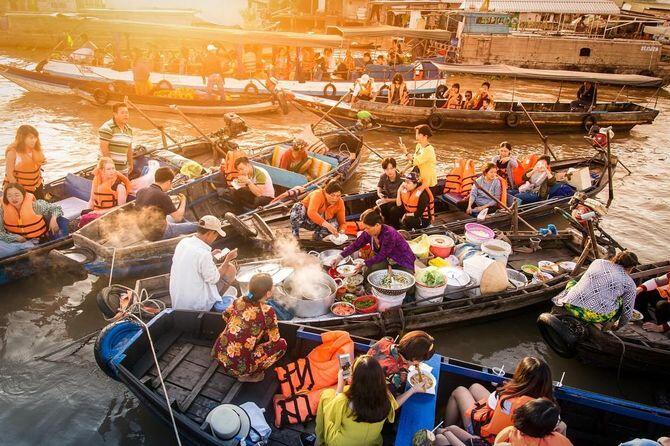
During the Duanwu Festival (the fifth day of the fifth month in the lunar calendar), visitors have the opportunity to participate in the unique tam con (bathing in the mudflat) festival. As the water recedes, exposing the sandy banks, locals and tourists bathe in the mud, believing it brings good health and a bountiful harvest.
A Troubling Reality
Despite being recognized by National Geographic Traveler as one of the top nine destinations for vacations in 2017, the Cai Be floating market faces a significant decline.
According to a report by the People’s Committee of Cai Be District (2024), the market’s commercial activities almost ceased after the COVID-19 pandemic. The development of road transportation and changing consumer habits are the primary reasons for this situation.
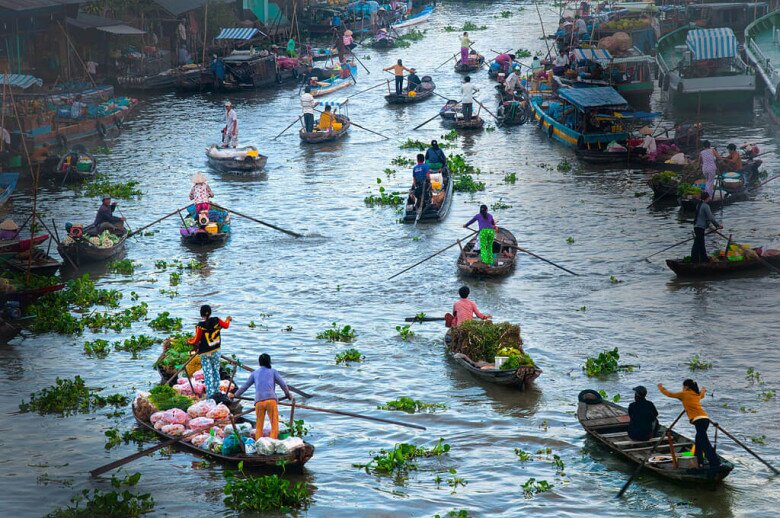
Currently, the floating market mainly caters to tourists. Only about 15-20 boats regularly trade here, a more than 90% decrease from its golden age.
A report by VOV (2024) confirms that many traders have switched professions due to the declining economic viability of river trading. Many have sold their boats and turned to onshore markets or e-commerce platforms.
Efforts to Preserve a Cultural Heritage
In response to the alarming situation, local authorities and tourism companies have implemented various measures to conserve this cultural heritage.
The “Conservation and Promotion of Cai Be Floating Market” project, launched in 2022, focuses on organizing tours that combine culinary and folk art experiences. A “cultural floating market” model is being developed, blending trading activities with folk art performances to create a captivating attraction for visitors.
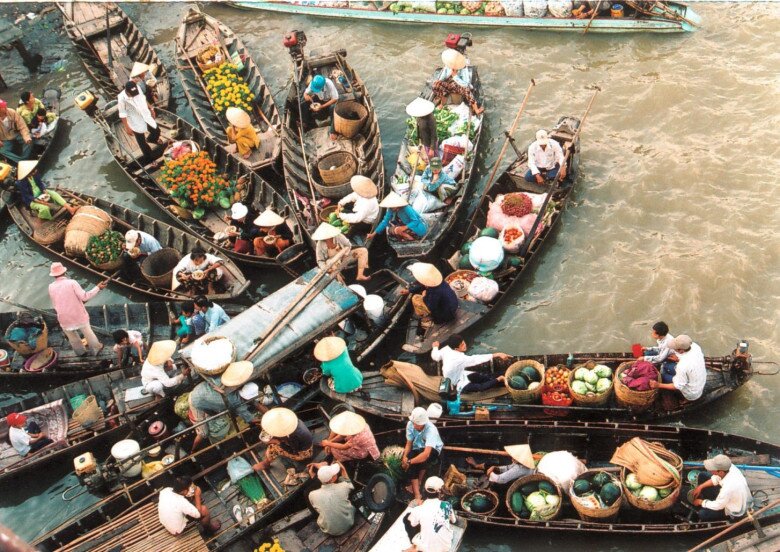
Tourism companies have designed itineraries that take visitors to the old market area and nearby fruit orchards. Tours to the Cai Be floating market are still available, even though it is not as bustling as before. Nevertheless, the cultural value and scenery continue to attract tourists, especially international visitors.
A Unique Tourist Experience Perseveres
Although the floating market no longer buzzes with commercial activity, unique tourist experiences are preserved for visitors. Tourists can rent a xuong ba la, a traditional means of transportation for the locals, to weave through the remaining trading boats. This experience offers an authentic glimpse into river life and provides photographic opportunities with the expansive river backdrop.
The culinary boats continue to cater to tourists, serving not only traditional breakfast dishes but also local specialties like lau ca keo (snakehead fish hot pot with water lily vegetables) or ca loc nuong trui (grilled snakehead fish wrapped in rice paper). Some tours even offer short lessons on don ca tai tu, a UNESCO-recognized intangible cultural heritage. Tourists are taught how to play the dan kim (a two-stringed instrument) or sing classical songs, providing a deeper understanding of the local culture.
Prospects and Suggestions for Revival
Despite the challenges, the Cai Be floating market retains significant tourism potential due to its unique cultural value. To restore and promote this heritage, cultural and tourism experts have proposed several solutions.
One effective suggestion is to recreate the floating market as a living museum, where visitors can not only tour but also engage in cultural activities characteristic of the Western region.

Developing diverse tourism products is a direction that many businesses are exploring. Combined tours that include visits to fruit orchards, craft villages, and the floating market are being organized to offer visitors a comprehensive experience. Promoting the market through digital platforms and collaborating with international film companies are considered effective strategies to introduce the Cai Be floating market to a broader audience.
The Cai Be floating market is not just a trading hub; it is a living testament to the cultural heritage of the Western region’s river life. Preserving this heritage requires a collective effort from society to ensure that future generations can marvel at this unique “floating market” amidst the vast river landscape.
The Half-Century-Old Market in Dong Nai: A Culinary Gateway to Hue’s Delights in the Heart of the Mekong Delta
Over half a century since its establishment, Cho Quang Bien has become more than just a bustling trading hub; it is a sanctuary for Hue’s soul in the heart of the Mekong Delta. Here, the cultural and culinary traditions of Central Vietnam are preserved and creatively evolved, offering a unique glimpse into the region’s rich heritage.
‘The Tomato-Throwing Good Luck Ritual at the Market’ Proposed for Heritage Status
The unique tomato-throwing festival, known as Thanh Hoa’s Chuong Fair, is a vibrant event held in Thanh Hoa City, Vietnam. This energetic celebration, a proposal for recognition as a national intangible cultural heritage, involves a fun and messy tradition of participants playfully pelting each other with tomatoes. It is believed that this playful tradition brings good luck and fortune, and it has become a drawcard for tourists seeking an authentic and exciting cultural experience.
The Heart of Tuyen Quang: A Glimpse into Vietnam’s Most Charming Rural Market
Nestled under the canopy of a centuries-old banyan tree, the Tua Lu Multi-century Market in Tan Thanh Commune, Son Duong District, Tuyen Quang Province has become an iconic cultural landmark in the northern mountainous region of Vietnam. With a history spanning hundreds of years and set against a backdrop of majestic natural scenery, this market is not just a hub for trade but also an emerging tourist destination that has captured the interest of many.


























